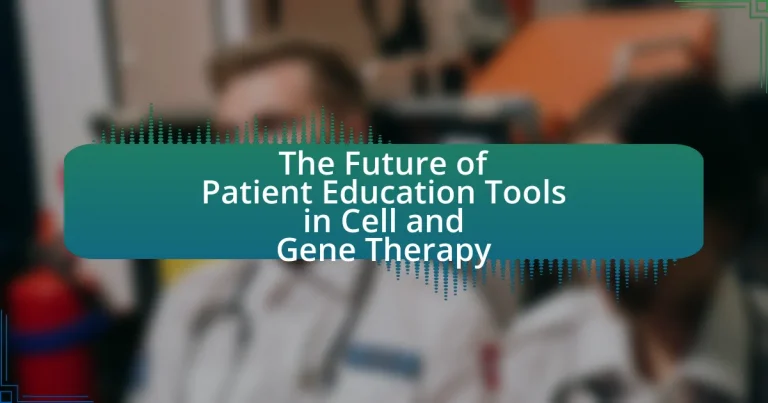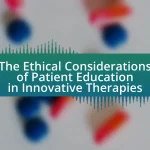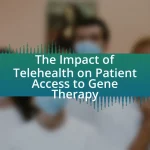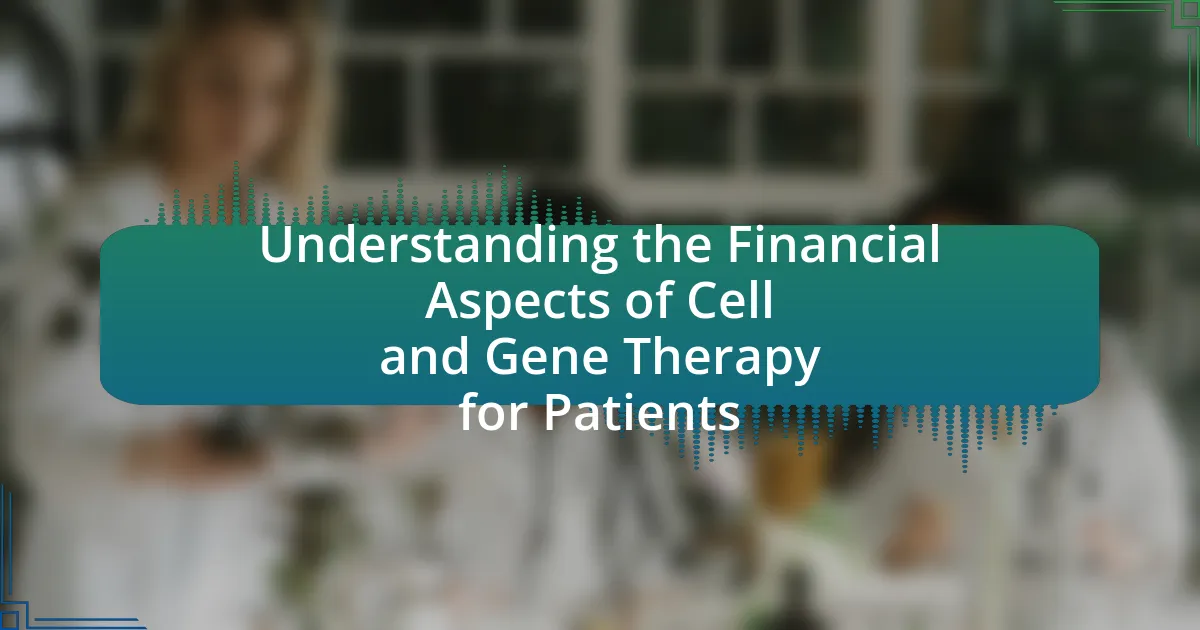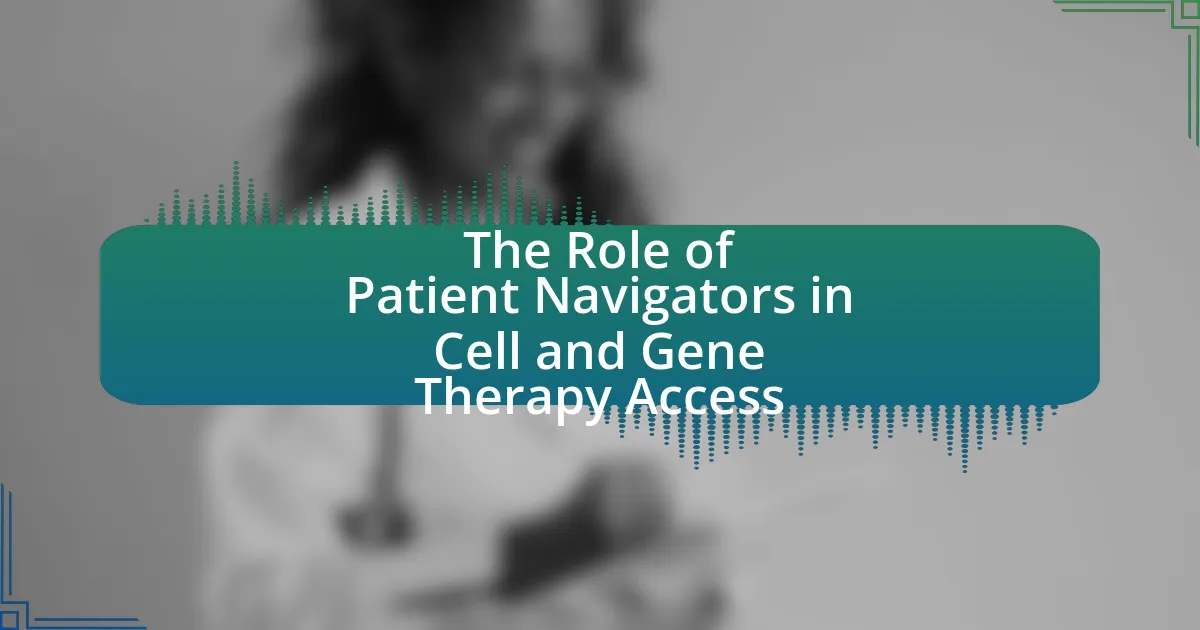Patient education tools in cell and gene therapy are essential resources that provide patients with vital information about their treatment options, procedures, and potential outcomes. These tools, which include brochures, videos, and interactive platforms, enhance patient understanding and engagement, leading to improved treatment adherence and health outcomes. The article explores the significance of effective patient education, the types of information these tools offer, and the role of informed consent in empowering patients. It also discusses current trends, challenges, and future developments in educational content delivery, emphasizing the importance of personalized and interactive approaches in enhancing patient comprehension and satisfaction.

What are Patient Education Tools in Cell and Gene Therapy?
Patient education tools in cell and gene therapy are resources designed to inform patients about their treatment options, procedures, and potential outcomes. These tools include brochures, videos, interactive websites, and mobile applications that provide clear, accessible information tailored to the complexities of cell and gene therapies. Research indicates that effective patient education can enhance understanding, improve treatment adherence, and reduce anxiety, ultimately leading to better health outcomes. For instance, a study published in the Journal of Genetic Counseling found that patients who utilized educational materials reported higher satisfaction and comprehension regarding their gene therapy treatments.
How do these tools enhance patient understanding?
Patient education tools enhance understanding by providing clear, accessible information about cell and gene therapy. These tools utilize visual aids, interactive platforms, and personalized content to simplify complex medical concepts, making them easier for patients to grasp. Research indicates that patients who engage with educational tools report higher comprehension levels and increased confidence in managing their health decisions. For instance, a study published in the Journal of Genetic Counseling found that patients using multimedia educational resources demonstrated a 30% improvement in understanding treatment options compared to those receiving standard information.
What types of information do these tools provide to patients?
Patient education tools in cell and gene therapy provide information on treatment options, potential side effects, and the mechanisms of action of therapies. These tools also offer guidance on managing health post-treatment, including lifestyle modifications and follow-up care. Evidence from studies indicates that such tools enhance patient understanding and engagement, leading to improved treatment adherence and outcomes. For instance, a study published in the Journal of Genetic Counseling found that patients who utilized educational resources reported higher satisfaction and confidence in managing their health.
How do these tools address patient concerns and misconceptions?
Patient education tools in cell and gene therapy address concerns and misconceptions by providing clear, evidence-based information tailored to individual patient needs. These tools utilize multimedia formats, such as videos and interactive platforms, to enhance understanding of complex therapies, thereby reducing anxiety and misinformation. For instance, studies have shown that patients who engage with educational resources report a higher level of understanding regarding treatment processes and potential outcomes, which directly correlates with improved satisfaction and adherence to therapy. By demystifying the science behind cell and gene therapies, these tools effectively empower patients to make informed decisions about their health.
Why is patient education crucial in cell and gene therapy?
Patient education is crucial in cell and gene therapy because it empowers patients to understand their treatment options, potential risks, and benefits, leading to informed decision-making. Informed patients are more likely to adhere to treatment protocols, which can enhance therapeutic outcomes. Studies indicate that effective patient education can improve treatment adherence rates by up to 80%, thereby maximizing the efficacy of innovative therapies. Furthermore, understanding the complexities of cell and gene therapy helps patients manage expectations and reduces anxiety, ultimately contributing to better overall health outcomes.
What role does informed consent play in patient education?
Informed consent is crucial in patient education as it ensures that patients understand the risks, benefits, and alternatives of their treatment options. This process empowers patients to make informed decisions regarding their healthcare, particularly in complex fields like cell and gene therapy, where treatments may involve significant risks and uncertainties. Research indicates that effective informed consent enhances patient comprehension and satisfaction, leading to better adherence to treatment plans and improved health outcomes. For instance, a study published in the Journal of Medical Ethics highlights that patients who receive thorough education about their treatment options are more likely to engage actively in their care and report higher levels of trust in their healthcare providers.
How can education improve treatment adherence among patients?
Education can improve treatment adherence among patients by enhancing their understanding of the treatment process and its benefits. When patients are well-informed about their condition and the importance of adhering to prescribed therapies, they are more likely to follow through with treatment regimens. Research indicates that educational interventions, such as personalized counseling and informational resources, can lead to a significant increase in adherence rates. For example, a study published in the Journal of Clinical Oncology found that patients who received comprehensive education about their cancer treatment adhered to their medication schedules 30% more than those who did not receive such education. This demonstrates that effective patient education is crucial in fostering a commitment to treatment adherence.
What are the current trends in patient education tools for cell and gene therapy?
Current trends in patient education tools for cell and gene therapy include the use of digital platforms, personalized educational content, and interactive multimedia resources. Digital platforms, such as mobile applications and online portals, facilitate easy access to information and support for patients undergoing these therapies. Personalized educational content tailors information to individual patient needs, enhancing understanding and engagement. Interactive multimedia resources, including videos and virtual reality experiences, provide immersive learning opportunities that help patients grasp complex concepts related to their treatment. These trends are supported by research indicating that personalized and interactive education improves patient comprehension and satisfaction, ultimately leading to better health outcomes.
How are digital platforms transforming patient education?
Digital platforms are transforming patient education by providing accessible, personalized, and interactive learning experiences. These platforms enable patients to access a wealth of information about their conditions and treatment options, including cell and gene therapies, at any time and from any location. For instance, studies show that patients who engage with digital educational tools demonstrate improved understanding of their treatment plans and increased adherence to therapies. Additionally, platforms often incorporate multimedia elements, such as videos and interactive quizzes, which enhance retention of information and cater to diverse learning styles. This shift towards digital education not only empowers patients but also fosters better communication between healthcare providers and patients, ultimately leading to improved health outcomes.
What innovations are emerging in educational content delivery?
Innovations in educational content delivery include the use of interactive digital platforms, personalized learning experiences, and augmented reality (AR) applications. Interactive digital platforms, such as online learning management systems, facilitate real-time engagement and feedback, enhancing the learning process. Personalized learning experiences leverage data analytics to tailor content to individual learner needs, improving retention and understanding. Augmented reality applications provide immersive experiences that allow learners to visualize complex concepts, particularly in fields like cell and gene therapy, where understanding intricate biological processes is crucial. These innovations are supported by research indicating that interactive and personalized approaches significantly enhance educational outcomes, making them essential in modern educational strategies.
How can we measure the effectiveness of patient education tools?
The effectiveness of patient education tools can be measured through various methods, including pre- and post-education assessments, patient feedback surveys, and health outcome tracking. Pre- and post-education assessments evaluate knowledge retention and understanding of the material presented, while patient feedback surveys provide insights into the usability and clarity of the educational tools. Health outcome tracking, such as monitoring adherence to treatment protocols or improvements in health metrics, offers concrete evidence of the impact of education on patient behavior and health status. Studies have shown that effective patient education can lead to a 25% increase in treatment adherence, demonstrating its significance in improving patient outcomes.
What metrics are used to evaluate patient comprehension?
Metrics used to evaluate patient comprehension include the Teach-Back method, comprehension assessments, and patient surveys. The Teach-Back method involves asking patients to explain back the information provided to them, ensuring they understand key concepts. Comprehension assessments can include quizzes or tests designed to measure knowledge retention and understanding of treatment plans. Patient surveys often gauge satisfaction and perceived understanding of the information shared during consultations. These metrics are validated by studies showing that effective evaluation of comprehension leads to improved patient outcomes and adherence to treatment protocols.
How do patient outcomes reflect the success of educational initiatives?
Patient outcomes serve as a direct indicator of the success of educational initiatives in healthcare. When patients receive effective education about their conditions and treatment options, they are more likely to adhere to prescribed therapies, leading to improved health metrics such as reduced hospital readmissions and enhanced quality of life. For instance, studies have shown that patients who participate in educational programs related to gene therapy exhibit higher treatment compliance rates, which correlates with better clinical outcomes. This relationship underscores the importance of tailored educational initiatives in empowering patients, ultimately resulting in measurable improvements in their health status.
What challenges do patient education tools face in cell and gene therapy?
Patient education tools in cell and gene therapy face challenges such as complexity of information, variability in patient understanding, and rapid advancements in technology. The intricate nature of cell and gene therapies often involves detailed scientific concepts that can be difficult for patients to grasp, leading to potential misunderstandings about treatment processes and outcomes. Additionally, patients come from diverse backgrounds with varying levels of health literacy, which complicates the effectiveness of educational materials. Furthermore, the fast-paced evolution of therapies means that educational resources can quickly become outdated, making it difficult for patients to receive the most current information. These challenges highlight the need for tailored, accessible, and regularly updated educational tools to enhance patient comprehension and engagement in their treatment journey.
How do technological barriers impact access to education?
Technological barriers significantly hinder access to education by limiting the availability of essential resources and tools necessary for effective learning. For instance, students without reliable internet access cannot participate in online courses or access digital learning materials, which has been highlighted by the fact that approximately 17% of U.S. households with school-age children lack high-speed internet, according to the Federal Communications Commission. Additionally, the absence of adequate devices, such as computers or tablets, further exacerbates educational inequities, as students in low-income areas often cannot afford the technology needed for remote learning. This digital divide creates disparities in educational outcomes, as those with limited access to technology are less likely to succeed academically compared to their peers with full access.
What are the common misconceptions that hinder effective education?
Common misconceptions that hinder effective education include the belief that all students learn in the same way, the assumption that technology alone can solve educational challenges, and the notion that memorization is the key to understanding. These misconceptions can lead to a one-size-fits-all approach, neglecting individual learning styles, which research shows can significantly impact student engagement and retention (Tomlinson, 2001). Additionally, relying solely on technology without proper pedagogical strategies can result in superficial learning experiences, as highlighted in studies by the Pew Research Center, which indicate that effective integration of technology requires thoughtful implementation (Pew Research Center, 2016). Lastly, emphasizing memorization over critical thinking can stifle creativity and problem-solving skills, essential for success in complex fields like cell and gene therapy, as noted in educational frameworks advocating for deeper learning (National Research Council, 2012).
What future developments can we expect in patient education tools for cell and gene therapy?
Future developments in patient education tools for cell and gene therapy will likely include enhanced digital platforms that utilize artificial intelligence and virtual reality to provide personalized, interactive learning experiences. These advancements aim to improve patient comprehension of complex treatment processes and potential outcomes. For instance, AI-driven chatbots can offer real-time answers to patient inquiries, while virtual reality simulations can visually demonstrate how therapies work at a cellular level. Research indicates that such immersive educational tools can significantly increase patient engagement and retention of information, leading to better treatment adherence and outcomes.
How might artificial intelligence enhance personalized education?
Artificial intelligence can enhance personalized education by analyzing individual learning patterns and tailoring educational content to meet specific needs. AI algorithms can assess a learner’s strengths, weaknesses, and preferences, allowing for customized lesson plans and resources that optimize engagement and retention. For instance, adaptive learning platforms utilize AI to modify the difficulty of tasks in real-time based on student performance, which has been shown to improve learning outcomes significantly. Research indicates that personalized learning approaches can lead to a 30% increase in student performance, demonstrating the effectiveness of AI in creating a more tailored educational experience.
What role will virtual reality play in patient education?
Virtual reality (VR) will play a transformative role in patient education by providing immersive, interactive experiences that enhance understanding of complex medical concepts. VR enables patients to visualize and engage with their treatment processes, such as cell and gene therapy, in a way that traditional educational methods cannot achieve. Studies have shown that immersive simulations can improve knowledge retention and reduce anxiety by allowing patients to explore their conditions and treatments in a safe environment. For instance, a study published in the Journal of Medical Internet Research found that VR significantly improved patient comprehension of surgical procedures compared to standard educational materials. This evidence supports the effectiveness of VR in making patient education more engaging and effective, particularly in the context of advanced therapies like cell and gene therapy.
What best practices should be followed in developing patient education tools?
Best practices in developing patient education tools include ensuring clarity, accessibility, and engagement. Clarity involves using simple language and avoiding medical jargon to facilitate understanding. Accessibility requires that materials are available in multiple formats (e.g., print, digital) and languages to cater to diverse patient populations. Engagement can be enhanced through interactive elements, such as videos or quizzes, which have been shown to improve retention of information. Research indicates that patient education tools that incorporate these elements lead to better patient outcomes, as evidenced by a study published in the Journal of Medical Internet Research, which found that interactive educational tools significantly increased patient knowledge and satisfaction.
How can healthcare providers ensure content is patient-centered?
Healthcare providers can ensure content is patient-centered by actively involving patients in the development and review of educational materials. This approach allows providers to tailor information to meet the specific needs, preferences, and understanding levels of patients, particularly in complex areas like cell and gene therapy. Research indicates that patient engagement in content creation leads to improved comprehension and satisfaction, as evidenced by a study published in the Journal of Medical Internet Research, which found that patient-involved educational resources significantly enhanced knowledge retention and decision-making. By prioritizing patient feedback and incorporating their perspectives, healthcare providers can create more relevant and effective educational tools.
What strategies can improve engagement and retention of information?
Utilizing interactive and multimedia content significantly enhances engagement and retention of information. Research indicates that incorporating visuals, such as videos and infographics, can improve information retention by up to 65% compared to text-only formats. Additionally, active learning strategies, such as quizzes and discussions, foster deeper understanding and memory retention, as they encourage patients to actively process and apply the information. A study published in the Journal of Medical Internet Research found that patients who engaged with interactive educational tools reported higher satisfaction and better comprehension of complex medical information.
